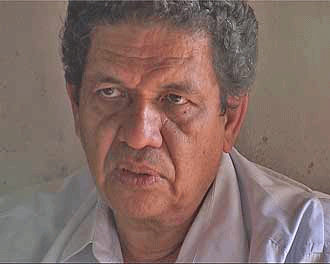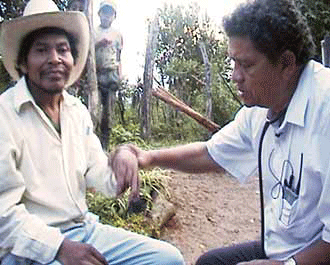 Anne Gyrithe Bonne and her cameraman Erik Molberg arrived in South Africa on the morning of the 11th September, 2001. The plan was to interview Archbishop Desmond Tutu three days later. The interview was primarily to be part of a film about people, who despite having been the victims of the most incredible suffering and oppression were fighting for reconciliation rather than revenge. The film's basic idea had taken shape over a period of years, the content of which this late summer's day had been summed up in the selected working title: The Will to Live. An assessment of the consequences of the fateful events, which took place in New York at the same time, fundamentally altered the perspective of the interview with Archbishop Tutu, and as such came to direct the filmmaker towards a much wider, and deeper emotional exploration of the original theme. The story of the single individual's will to survive became in the actual process the straightforward story about how our greatly differing understanding of the concepts of Love, Hate and Reconciliation influence us all - and thereby our continuing existence.
Anne Gyrithe Bonne and her cameraman Erik Molberg arrived in South Africa on the morning of the 11th September, 2001. The plan was to interview Archbishop Desmond Tutu three days later. The interview was primarily to be part of a film about people, who despite having been the victims of the most incredible suffering and oppression were fighting for reconciliation rather than revenge. The film's basic idea had taken shape over a period of years, the content of which this late summer's day had been summed up in the selected working title: The Will to Live. An assessment of the consequences of the fateful events, which took place in New York at the same time, fundamentally altered the perspective of the interview with Archbishop Tutu, and as such came to direct the filmmaker towards a much wider, and deeper emotional exploration of the original theme. The story of the single individual's will to survive became in the actual process the straightforward story about how our greatly differing understanding of the concepts of Love, Hate and Reconciliation influence us all - and thereby our continuing existence.
 At the very heart of The Will to Live is the search for the broadest possible range of expressions of humanity. For whilst the film's central structure unfolds around the interviews with - and the portraits of - the three central figures: Nobel Peace Prize winner Desmond Tutu in South Africa; human rights campaigner and doctor, Juan Almendares in Honduras, and the Cambodian writer Chanrithy Him in the U.S.A. - it is actually in the insistent DV footage shot by Anne Gyrithe Bonne on her travels to and from three continents, that the film reflects our differing ideas about love, hate and reconciliation. And it is here too, that the film best pursues its exploration of opportunities provided by forgiveness - and The Will to Live! The goal of the film - an authentic representation of our universal attempt to achieve reconciliation in a world, where reconciliation is perhaps the only choice available to us - is to encourage people to think.
At the very heart of The Will to Live is the search for the broadest possible range of expressions of humanity. For whilst the film's central structure unfolds around the interviews with - and the portraits of - the three central figures: Nobel Peace Prize winner Desmond Tutu in South Africa; human rights campaigner and doctor, Juan Almendares in Honduras, and the Cambodian writer Chanrithy Him in the U.S.A. - it is actually in the insistent DV footage shot by Anne Gyrithe Bonne on her travels to and from three continents, that the film reflects our differing ideas about love, hate and reconciliation. And it is here too, that the film best pursues its exploration of opportunities provided by forgiveness - and The Will to Live! The goal of the film - an authentic representation of our universal attempt to achieve reconciliation in a world, where reconciliation is perhaps the only choice available to us - is to encourage people to think.
1 2 3 4 5
|

 Anne Gyrithe Bonne and her cameraman Erik Molberg arrived in South Africa on the morning of the 11th September, 2001. The plan was to interview Archbishop Desmond Tutu three days later. The interview was primarily to be part of a film about people, who despite having been the victims of the most incredible suffering and oppression were fighting for reconciliation rather than revenge. The film's basic idea had taken shape over a period of years, the content of which this late summer's day had been summed up in the selected working title: The Will to Live. An assessment of the consequences of the fateful events, which took place in New York at the same time, fundamentally altered the perspective of the interview with Archbishop Tutu, and as such came to direct the filmmaker towards a much wider, and deeper emotional exploration of the original theme. The story of the single individual's will to survive became in the actual process the straightforward story about how our greatly differing understanding of the concepts of Love, Hate and Reconciliation influence us all - and thereby our continuing existence.
Anne Gyrithe Bonne and her cameraman Erik Molberg arrived in South Africa on the morning of the 11th September, 2001. The plan was to interview Archbishop Desmond Tutu three days later. The interview was primarily to be part of a film about people, who despite having been the victims of the most incredible suffering and oppression were fighting for reconciliation rather than revenge. The film's basic idea had taken shape over a period of years, the content of which this late summer's day had been summed up in the selected working title: The Will to Live. An assessment of the consequences of the fateful events, which took place in New York at the same time, fundamentally altered the perspective of the interview with Archbishop Tutu, and as such came to direct the filmmaker towards a much wider, and deeper emotional exploration of the original theme. The story of the single individual's will to survive became in the actual process the straightforward story about how our greatly differing understanding of the concepts of Love, Hate and Reconciliation influence us all - and thereby our continuing existence.  At the very heart of The Will to Live is the search for the broadest possible range of expressions of humanity. For whilst the film's central structure unfolds around the interviews with - and the portraits of - the three central figures: Nobel Peace Prize winner Desmond Tutu in South Africa; human rights campaigner and doctor, Juan Almendares in Honduras, and the Cambodian writer Chanrithy Him in the U.S.A. - it is actually in the insistent DV footage shot by Anne Gyrithe Bonne on her travels to and from three continents, that the film reflects our differing ideas about love, hate and reconciliation. And it is here too, that the film best pursues its exploration of opportunities provided by forgiveness - and The Will to Live! The goal of the film - an authentic representation of our universal attempt to achieve reconciliation in a world, where reconciliation is perhaps the only choice available to us - is to encourage people to think.
At the very heart of The Will to Live is the search for the broadest possible range of expressions of humanity. For whilst the film's central structure unfolds around the interviews with - and the portraits of - the three central figures: Nobel Peace Prize winner Desmond Tutu in South Africa; human rights campaigner and doctor, Juan Almendares in Honduras, and the Cambodian writer Chanrithy Him in the U.S.A. - it is actually in the insistent DV footage shot by Anne Gyrithe Bonne on her travels to and from three continents, that the film reflects our differing ideas about love, hate and reconciliation. And it is here too, that the film best pursues its exploration of opportunities provided by forgiveness - and The Will to Live! The goal of the film - an authentic representation of our universal attempt to achieve reconciliation in a world, where reconciliation is perhaps the only choice available to us - is to encourage people to think.